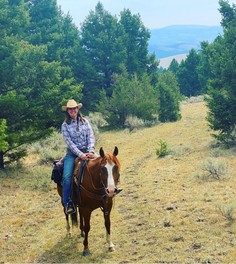
Meet the Montana Rangeland Resources Committee!
Leah Lewis – Rangeland Resource Committee
My name is Leah Lewis, I work with my family on the Compton Ranch in Boulder, Montana. I became a new member to the Rangeland Resource Committee in 2021 and have lots to catch up on!
I have a Range Science degree from Montana State University, and I’m quite comfortable calling myself a plant nerd. I worked for the Forest Service for many years in Range and Invasive Species Management before “retiring” to work full time on our ranch that raises Gelbveih/Angus cross cow-calf pairs. It has been an honor and a privilege to work with the many wonderful people connected to agriculture. However, things have felt quite differently as of late.
I sit down to go through my mail and a dark cloud comes over my head. It’s unfortunately not a rain cloud (which we so desperately need!), but a metaphorical cloud of real estate flyers and land broker advertisements. I opened up the latest issue of Land Investor and instantly feel physically nauseous when I notice a ranch 40 miles away is listed for millions of dollars. I force myself to keep reading, with one article touting rural land as being an essential component of one’s investment portfolio, all while claiming to be protecting the natural resource from subdivisions. Disgusted, I get up from my desk and go outside. That afternoon I can’t stop thinking, “Does being rich make you a better conservationist?” It seems the trend that only multi-millionaires or billionaires can buy ranches these days. How can the small generational family ranch compete? I can tell you from experience that paying for a 20 year old diesel pickup for the outrageous price of $24,000 in today’s market, can suck the creative juices right out of a range improvement project.
I thought back to all the different Range projects we’ve completed over the past several decades and realized most of those projects didn’t take money to be successful, they took friends and neighbors willing to extend a helping hand. We literally had a “chainsaw party” one day to help cut trees in preparation for an upcoming prescribed burn. Just last summer, several friends spent the morning helping me cut and bag houndstongue. These types of projects can be extremely impactful and only cost the grocery bill of food preparation and refreshments for the crew.
As Theodore Roosevelt once said “Do what you can, with what you have, where you are”. The warm weather is coming, now is the time to reach out to friends/neighbors and offer to help with THEIR upcoming Range projects...that good karma will circle back to you in the future!
|
 DNRC Welcomes Four Working Lands Internship Program Interns
Starting this month, the four Working Lands Interns, Jo, Autumn, Bridger, and Joe will spend two weeks at six different host ranches across the state working and learning about rangeland monitoring, plant & weed identification, ranch economics, rotational grazing and other vital ranch operations.
This internship is designed to offer students majoring in any natural resources field, real-world and hands-on experience while implementing the educational tools already gained to a ranching operation.
The Rangeland Resources Program would like to extend a warm welcome to the four interns selected and a gratitude filled Thank You to all ranch mentors!
Learn more about the Working Lands Internship Program.
 Attorney General Knudsen Warns Montana Ranchers Of Cattle Feed Scams
HELENA – Montana Attorney General Austin Knudsen is warning Montanans of a scams that could be impacting many Montana ranchers. One investigation is still ongoing, but the Office of Consumer Protection estimates that a Canadian company has stolen up to $5 million from Montanans after receiving payments but never delivering the promised product – and other criminals may be conducting similar scams.
The company, New Way Ag, promised grain hay, barley straw, and wheat straw at low prices to quickly make sales, collected payments, and then never delivered any product to their victims. To aid in the investigation, Montanans who made payments to New Way Ag should contact the Montana Office of Consumer Protection at 406-444-4500.
Read the News Release, here.

FarmProgress: Researchers Study if Larkspur Tolerance is Inheritable
Domestic cattle losses in the US due to toxic plants can number up to $50 million per year. Larkspur, a perennial native to the western US, is one of the plants that can be lethal to cattle.
Through their USDA research on toxic plants, Ben Green, USDA-ARS Pharmacologist and Dan Cook, USDA Plant Physiologist, had recorded anecdotal data of cattle able to consume large quantities of larkspur without ill effects. They are now two years into a study to verify why. The researchers feed two pounds of powdered larkspur plant material daily to cattle that weigh about 1,000 pounds. The researchers phenotype the cattle by exercising them after dosage and recording time to clinical sign.
Green and Cook began their research with three cattle breeds: Angus, Hereford and Holstein.
Read the full article, here!
|
FarmProgress: EPA Ag Adviser Offers Update on WOTUS, Pesticides
Rod Snyder, Environmental Protection Agency agricultural adviser, offered important updates on how the agency plans to address issues impacting the ag sector including pesticide reviews, the waters of the U.S. rule and making decisions based on science while speaking to the North American Agricultural Journalists on April 25.
EPA recently announced a new pesticide review policy which hopes to help avoid lawsuits and offer certainty as the agency tries to comply with the Endangered Species Act as it registers and reviews pesticides. The workplan was mandated by Congress in the 2018 Farm Bill. Snyder calls this a “leadership moment for the agency” to step up and find a way to address a process that has extended the time of review for pesticides and created a backlog.
Snyder also says he has had many conversations with EPA Administrator Michael Regan on climate change and how EPA can play a supporting role with USDA and farmers. In restarting a farmer, rancher and rural community advisory committee, Reagan issued a new two-year charge to that committee to explore how EPA can support agriculture’s climate goals looking at both adaptation and mitigation efforts to support policies into the future.
Read the full article, here.
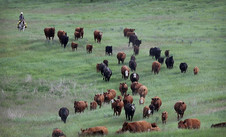
FarmProgress: Economic Benefits of Co-Grazing in Cattle Operation
Adding meat goats to your beef cattle operation may improve your financials, says Jennifer Lutes, University of Missouri Extension agricultural business specialist.
Lutes developed a model that looks at the economics of co-grazing — a diversification strategy involving production of more than one livestock species on the same farm. According to her model, this type of scenario generated higher profit per labor hour and per acre, along with a higher net income than scenarios that involved producing only cattle or goats.
Read the full article, here!
|
Beef Magazine: Cattle Producers Should be on the Lookout for New Tick Species
All types of ticks are blood-feeding ectoparasites which can be vectors for viruses, bacteria and parasites. Cattle producers and other animal owners have dealt with these pests for decades, but the increasing spread of the Haemaphysalis longicornis, or Asian longhorned tick, has veterinarians concerned.
The Asian longhorned tick is one to be on the lookout for. While it has been found in 15 states in the Eastern U.S., Missouri and Arkansas, it is a tick that can be misidentified.
The female will lay thousands of eggs at one time and can do so without mating. This native to Asia will feed on cattle, horses, small ruminants, humans and other animals, but prefers a larger host. It is a potential carrier of Anaplasma, Ehrlichia, Babesia and other diseases. In New Zealand, this tick is a carrier of Theileria, which is often misdiagnosed as Anaplasma. This disease can cause reluctance to walk, weakness, abortion, mucosal pallor and pyrexia.
Read the full article, here!

Beef Magazine: Develop Cattle Grazing Plan with these 4 Apps
AgriWebb. This app allows you to keep track of animal days per acre on a pasture, along with rest and recovery time for each paddock. You need to input the data to start, but the app provides a map that shows how many days of recovery per pasture.
PastureMap. This is the most user-friendly app for graziers that allows tracking multiple species, or even types of cattle using color. Each color represents a different animal like sheep or cattle, and breaks down to cows or bulls as well. The app helps predict pasture rotation based on visual estimates of your clippings, forage allocation for the herd and how many days you want the cattle to stay in a pasture. Then you schedule the next move, and the app sends you an alert as a reminder
MaiaGrazing. The unique feature of this grazing app is a chart that displays historical data. You can use it to create a current or future grazing management plan. The app also offers a pasture breakdown, including animal days per acre, how many days grazed that year, and average recovery time or rest periods before reentering a pasture.
PictureThis. A plant identification app that allows you to take a photo of a weed and automatically identifies it during dormant and active growing seasons.
Read the full article, here!
|
Don't Forget! Register for 406 Grazing Academy!
The last day to register for the 406 Grazing Academy is May 16th. To register, please contact Teresa at Judithbasincd@macdnet.org
This year's 406 Grazing Academy will take place in Lewistown, MT at the Yogo Inn with Field activities held on working ranches near Winnett, MT.
Participants will gain practical information to help them make strategic decisions for their ranch. Topics include economic optimum stocking rates, diverse grazing strategies, range monitoring, extending the grazing season, livestock-wildlife relations, targeted grazing, and coping with drought, wildfire and poisonous plants. Successful Montana ranchers and other range managers from across the state will share their expertise and complement presentations by the educators.
Registration is $150/person or $250 for two people from the same ranch. Registration covers educational materials, noon and evening meals. Participants are responsible for travel and lodging expenses.
View the Save the Date flyer.
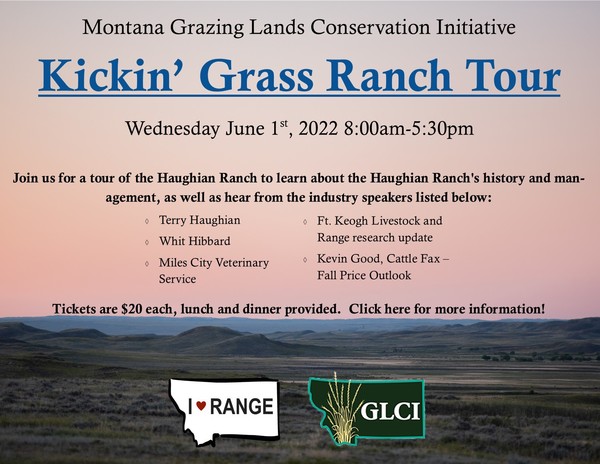
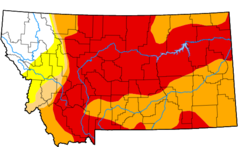
Managing Grass in a Drought-Ravaged World
By: Rick Caquelin, Retired USDA NRCS State Range Specialist
There is no doubt about it, across most of Montana the 2021 growing season left a lot to be desired. Over most of the eastern two-thirds of the state, precipitation was 60% of normal or less. These areas were also affected by unusually hot temperatures. A rare, late August rainfall created a small burst of fall green-up that quickly withered in the face of continued dry conditions and the appetites of voracious grasshoppers before fall frosts could mark the end of the growing season.
So, what does that leave us expecting for pasture and range conditions in 2022?
Read the full recommendations, here!
|
Forecasting Drought and Finding Solutions
Along with much of the Western United States, Montana is heading into another dry year. More than 80% of the state is currently experiencing severe to extreme drought conditions, and soil moisture remains low. Here are some resources to help our local communities cope while protecting our precious waterways:
- MWCC hosts a Real-Time Resources page with links to updated snowpack and water supply outlooks, drought conditions, and stream flows.
- The National Oceanic and Atmospheric Administration hosts soil moisture forecasting tools.
-
A new video from Intermountain West Joint Venture shows how partners in New Mexico’s Middle Rio Grande Valley are using science and traditional ecological knowledge to inform conservation that will help mitigate a drier future and provide benefits for wildlife and people.
 |
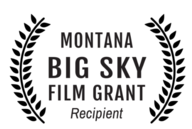
MPLC Receives Film Grant to Tell the Story of Public Lands Grazing
The Montana Public Lands Council was recently awarded a $25,000 Big Sky Film Grant to produce a documentary on public land grazing. The short-form film, which will run five to six minutes, will take a closer look into the story of the American West and the important role public lands play. Of the $1.5 million awarded through the Montana Film Office, MPLC was one of 17 short-form films that received grant funding.
Following in the footsteps of Montana ranching families, the film will bring a personal perspective of the stories and places. Hitting on the challenges and significant historical periods that created a multiple-use conservation movement, the story will expand on how the generation of the past strategically utilized public lands in a way that had never been done before.
Read the full Press Release, here!
|
Women in Conservation Ranching- Three Montana Women Featured
Montana Audubon featured the following three Montanan Women and highlighted their land stewardship efforts.
Heather Bilden, Coulee Creek Ranch- Lavina, MT
Kristi Patterson, P Bar Ranch- Cowgirl Meat Co.- McLeod, MT
Jamie Stoltzfus, P Bar Ranch- Cowgirl Meat Co.- McLeod, MT
Check out the interviews here!
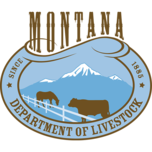
Department of Livestock Revises Brand Policy to Better Serve Montana Ranchers
On Monday, April 4th, the Montana Department of Livestock (MDOL) implemented an updated policy for recording, transferring, and rerecording of brands.
The policy was developed by a committee of state legislators, representatives of industry organizations, members of the Board of Livestock, and MDOL staff in response to the industry’s requests for increased availability of 2-character brands. Major changes include additional acceptable characters, more lenient format guidelines, and the elimination of over 40% of regional character conflicts.
Read the News Release, here.
|

Free Counseling Services Now Available to Montana's Ag Community
The Montana Department of Agriculture and Frontier Psychiatry have partnered to provide free access to counseling for Montanans involved in agriculture. Funded through the United States Department of Agriculture’s (USDA) Farm and Ranch Stress Assistance Network (FRSAN), this partnership provides a variety of services, including individual counseling, tele-health, and medication management, at no cost to the participant.
The program is open to any Montanan involved in the agriculture. Visit frontier.care/beyondtheweather or call (406) 200-8471, Press 7 to learn more and schedule an initial appointment.
Read the full article, here.
Montana Student Loan Assistance Program Preserves Family Farms and Ranches
The Montana Department of Agriculture’s (MDA) Student Loan Assistance Program is now accepting applications. Established during the 2019 legislative session, this program provides student loan assistance to Montana’s college-educated youth pursuing careers in farming or ranching.
Qualified farmers and ranchers are eligible for student loan assistance through the program for up to five years. Applicants must be a Montana resident designated as the primary owner, heir, successor or assignee of a farm or ranch in Montana that obtained their associated or baccalaureate degree(s) from a Montana college or university and have agreed to operate their farm or ranch for at least five years.
Applications are due May 23, 2022 and can be submitted through Amplifund. Full program guidelines are available on the department’s website at agr.mt.gov/Student-Loan-Assistance-Program.
 |
BLM Acquires Montana parcel from The Nature Conservancy
On April 6, the BLM used $6.8 million from the Fund to purchase the 4,600-acre Ninemile Prairie parcel from The Nature Conservancy to ensure permanent public access to former industrial timber land about 30 miles east of Missoula. The Ninemile parcel is part of the 1.5-million-acre Blackfoot River Watershed project, a cooperative effort of federal, state, and private land managers to ensure the continued health and resilience of ecological and human communities, and to improve public access to an area that offers high-quality hunting and hiking as well as limited summer and winter motorized use.
The area is also important habitat for grizzly bears, Canada lynx, bull trout, Westslope cutthroat trout and other species. Since 1998, the BLM has acquired approximately 36,800 acres of former private timber land in the Blackfoot River watershed from The Nature Conservancy. This month’s acquisition furthers the mutual goals of protecting the watershed and improving public access. The BLM plans to purchase the adjacent Woodchuck parcel later this year.
Read the full Press Release, here.
Bureau of Land Management Montana/Dakotas Issues Notice for Oil and Gas Lease Sale
The Bureau of Land Management (BLM) Montana/Dakotas State Office issued a final Environmental Assessment and sale notice for a June 2022 lease sale.
Today’s notice incorporates recommendations from the Department of the Interior’s Report on the Federal Oil and Gas Leasing Program, as well as other reports issued by the Governmental Accountability Office and Congressional Budget Office.
The BLM is applying a first-ever increased royalty rate of 18.75% for the leases sold in the current competitive lease sales, in keeping with rates charged by States and private landowners.
The BLM Montana/Dakotas State Office will move forward with Alternative C, as analyzed in the environmental assessment (DOI-BLM-MT-0000-2021-0006-EA), by offering 23 parcels totaling 3,405.8 acres in Fallon, Powder River, Richland and Roosevelt Counties in Montana. The parcels will be offered at the online oil and gas lease sale scheduled for June 28, 2022; the sale can be accessed at www.energynet.com.
Additionally, today’s posting of the sale notice initiates a 30-day public protest period that ends on May 20, 2022. Protests on the offered parcels may be submitted electronically through ePlanning by accessing the lease sale site at https://eplanning.blm.gov/eplanning-ui/project/2015346/510.
Read the full News Release, here!

New Report Shows Economic Value of Farm Bill Conservation Easements
The Natural Resources Conservation Service (NRCS), Montana Association of Land Trusts (MALT), and the Heart of the Rockies Initiative have partnered to produce a 20-page report analyzing the economic impact of conservation easements in Montana. The report concludes that since it was created in the 2014 Farm Bill, the Agricultural Land Easement (ALE) program has produced a $182 million economic benefit to Montana agricultural producers, rural main streets, rural economies, and the state’s overall economy.
The report, titled “Working for Montana Agriculture: Economic Benefits of Conservation Easements for Montana’s Farms, Ranches and Communities,” is believed to be the first comprehensive examination of the economic benefits related to the ALE program in Montana.
The report shows:
- Between 2014 and 2021 the NRCS, farm and ranch families, and land trusts (or state agency) teamed up to invest $109 million from the Farm Bill ALE program to conserve 289,000 acres of ag lands in 22 Montana counties.
- Every ALE Farm Bill dollar allocated to farm and ranch conservation yielded $1.89 of economic activity, nearly doubling the positive impact of the Farm Bill funding.
- 95% of the allocated funds were used to directly assist with farm and ranch agricultural operations and expansion, farm and ranch family succession planning, business strength and stability, and direct purchase of farm and ranch equipment.
- These dollars produced a total economic impact of $182 million for Montana’s economy, supported 1,057 local jobs and $41.5 million in labor income, and contributed $99 million to Montana’s Gross Domestic Product.
The report also points out that since 1990 Montana has lost 1.3 million acres of undeveloped land.
Read the full News Release, here!
USDA Announces Investment in Six Watershed Infrastructure Projects to Benefit Rural and Historically Underserved Communities in Montana
Agriculture Secretary Tom Vilsack announced the U.S. Department of Agriculture (USDA) will invest $420 million in 132 infrastructure projects in 31 states, including a $330,000 investment in six projects in Montana. These projects include rehabilitating dams, flood prevention, and watershed restoration projects, and they are part of the implementation of the Bipartisan Infrastructure Law (BIL), building on a $166 million nationwide investment announced earlier this year.
Projects in Montana include:
-
Fort Peck Tribes – Wolf Point Irrigation Project BIL WFPO funding will be used to implement ag-water management methods to build towards climate resiliency. Funds are needed to modernize the Wolf Point Irrigation Project water delivery system.
-
Helena Valley Irrigation District BIL WFPO funding will be used to implement ag-water management methods to build towards climate resiliency. Funds are needed to modernize the Helena Valley Irrigation District water delivery system.
-
Kinsey Irrigation District BIL WFPO funds will be used to perform a feasibility study on a proposed watershed project that would rehabilitate and modernize the Kinsey Irrigation District water delivery system located in the Cabin Creek - Yellowstone River watershed near Kinsey, Montana.
-
Missoula Conservation District BIL WFPO funding will be used to implement ag-water management methods to build towards climate resiliency. Funds are needed to modernize the Missoula Conservation District Irrigation District water delivery system.
-
Tongue & Yellowstone River Irrigation District BIL WFPO funding will be used to implement ag-water management methods to build towards climate resiliency. Funds are needed to modernize the Tongue & Yellowstone River Irrigation District delivery system.
-
Wyota Irrigation Project BIL WFPO funding will be used to implement ag-water management methods to build towards climate resiliency. Funds are needed to modernize the Wyota Irrigation Project water delivery system.
Read the full News Release, here!

Emergency Livestock Relief Program (ELRP)
To help agricultural producers offset the impacts of natural disasters in 2020 and 2021, Congress included emergency relief funding in the Extending Government Funding and Delivering Emergency Assistance Act (P.L. 117-43). This law targets at least $750 million for livestock producers impacted by drought or wildfires.
USDA is working diligently to develop the programs, policies and provisions required to equitably distribute these much-needed payments to producers hard-hit by catastrophic disaster events the past two years. Through proactive communication and outreach, USDA will keep producers and stakeholders informed as program details are available.
Funds will be distributed in two phases through the Emergency Livestock Relief Program (ELRP) and the Emergency Relief Program (ERP).

USDA Takes Action to Ensure Continued Rapid Response to Highly Pathogenic Avian influenza in the United States
USDA’s Animal and Plant Health Inspection Service (APHIS) is leading a growing response to a large outbreak of highly pathogenic avian influenza (HPAI). To date, the virus has been confirmed in 29 states, affecting more than 33 million domestic birds. APHIS is working closely with State animal health officials on joint incident responses in each of the affected states.
To help ensure APHIS can continue to provide critical rapid response activities, Agriculture Secretary Tom Vilsack approved the transfer of nearly $263 million from the Commodity Credit Corporation to APHIS to directly support the response efforts. The funding allows APHIS to continue its critical work with state and local partners to quickly identify and address cases of HPAI in the United States.
Read the full News Release, here!

Newly Discovered Protein in Fungus Bypasses Plant Defenses
A protein that allows the fungus that causes white mold stem rot in more than 600 plant species to overcome plant defenses has been identified by a team of U.S. Department of Agriculture Agricultural Research Service and Washington State University scientists.
Knowledge of this protein, called SsPINE1, could help researchers develop new, more precise system of control measures for the Sclerotinia sclerotiorum fungus, which attacks potatoes, soybeans, sunflowers, peas, lentils, canola, and many other broad leaf crops. The damage can add up to billions of dollars in a year of bad outbreaks.
The discovery of SsPINE1 has opened new avenues to investigate for controlling white mold stem rot pathogens, including possibly even more effective, more targeted breeding to make plants naturally resistant to sclerotinia diseases. And the team has showed that other related fungal pathogens use this counter-strategy, which only serves to make this discovery even more important.
Read the full News Release, here!


A West-Wide Rangeland Fuel Assessment: Reading the Tea Leaves
In this monthly recorded series, Dr. Matt Reeves, an RMRS Research Ecologist specializing in remote sensing and ecological modeling, will analyze current rangeland fuel conditions across the west, with emphasis on emerging hotspots. New episodes will be posted on the first Monday of every month and more frequently as the summer progresses.
Projections are based on Reeves' Fuelcasting system, a new program that provides projections of expected fuel conditions this grazing season. It is an important component of the Rangeland Production Monitoring System.
Listen here!
|
MSU Extension:
Updated MontGuides
University of Montana:
Rangeland Analysis Platform
Reversing Tree Encroachment Increases Usable Space for Sage-Grouse during the Breeding Season
USDA-Agricultural Research Service
Scientific Discoveries 2022
Rangeland Resources & Systems Research, Fort Collins, CO:
Livestock and Range Research Laboratory, Miles City, MT:
Pest Management Research, Sidney, MT:
US Forest Service Research & Development:
Research topic: Fire
Research topic: Water, Air, & Soil
May 2022:
- May 1st, Noxious Weed Management Advisory Council Applications Due
- May 1st, Montana Stockgrowers M Bar Academy Applications Due
- May 2nd, NRCS Conservation Innovation Grant Applications Due
-
May 3rd - Role of Plant Physiology in Weed-Crop Competition
- May 6th, Congressional Primary Debate- Bozeman
-
May 10th - Molecular Basis for Controlling Invasive Plant
- May 14th, Montana CattleWomen Scholarship Applications Due
- May 16th, Montana Association of State Grazing District Annual Meeting- Lewistown
-
May 17th - Addressing Herbicide Resistance with Alternative Chemistries
- May 20th, Congressional Primary Debate- Whitefish
- May 20-21st, Crazy Mountain Fiber Fest- Big Timber
- May 23rd, Montana Agriculture Student Loan Assistance Application Deadline
-
May 24th - Spread and Distribution of Invasive Plants
-
May 31st - Climate Change Effects on Weeds and Management
- May 31st, Rangeland Resources Committee Meeting- Miles City
June 2022:
Stacey Barta, State Coordinator for Rangelands
220 W. Lamme, Suite 1A
Bozeman, MT 59715
(406) 594-8481
SBarta@mt.gov
Emily Moran, Administrative Assistant for Rangelands
PO Box 201601
Helena, MT 59601
(406) 444-2613
Emoran@mt.gov
Rangeland Resources Committee:
Diane Ahlgren, Chair
John Hollenback, Vice Chair
Sigurd Jensen
Jim Anderson
Leah Lewis
Ron Devlin
|